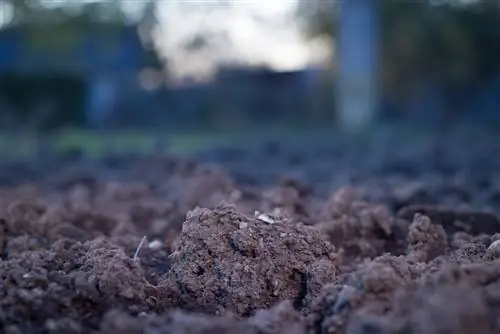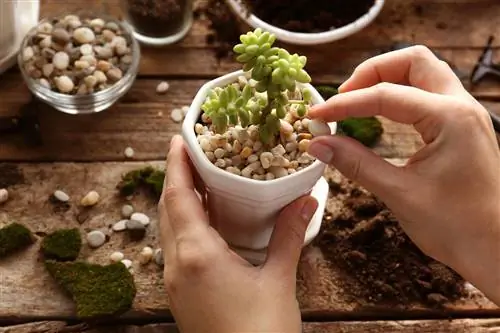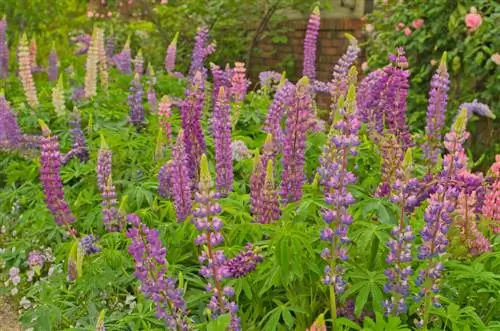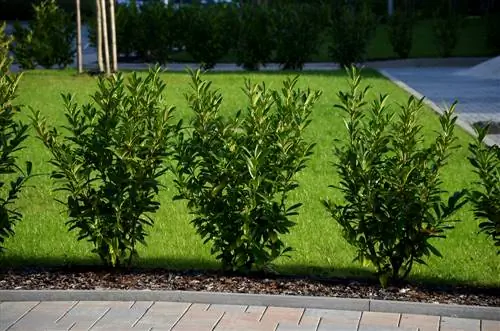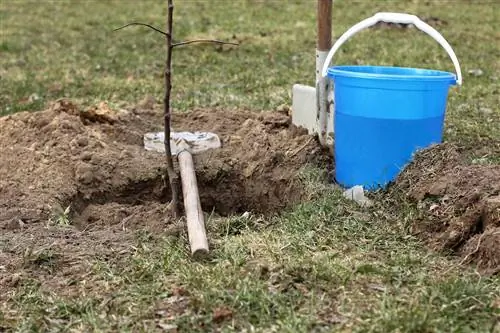- Author admin [email protected].
- Public 2023-12-16 16:46.
- Last modified 2025-06-01 06:02.
If clay soil comes under the wheels of construction machinery and heavy equipment, its plant-suitable quality is lost. This guide explains how you can skillfully improve compacted clay soil and transform it into exemplary garden soil. Practical tips show how drainage in garden clay soil optimizes rainwater infiltration. Find out here which plants thrive in clay soil.

How do you improve compacted clay soil in the garden?
To improve compacted clay soil in the garden, you should dig up the soil, incorporate mature compost, spread sand and, if necessary, lime. Drainage in clay soil can optimize rainwater infiltration and a selection of suitable plants ensures he althy growth.
- Mature compost and fine-grained quartz sand are effective ways to improve compacted, wet clay soil.
- Drainage in the garden clay soil with a seepage trough guarantees permanent protection against waterlogging.
- Roses, hydrangeas, apple trees and many other plants like clay soil if rainwater infiltration works.
Improve clay soil - How to do it
Clay soil has a very fine-grained structure that tends to become massively compacted. A high proportion of sound exacerbates the problem. The soil becomes so solid and sticky that plant roots are slowed down in their growth. Rainwater cannot drain away or can only drain away very slowly. The fatal consequence is waterlogging in the upper layers of the soil, which can be seen in puddles in the lawn and beds. As a result of water saturation, valuable lime is washed away, whereupon the pH value drops and the garden soil becomes acidic. It doesn't have to come to this if you loosen up clay soil and make it more permeable. How to improve clay soil with gardening expertise:
- Dig the soil to the depth of a spade, rake vigorously, remove weeds, stones and impurities
- Work mature compost soil into the clay soil (3-5 l/m² at least)
- smooth the improved clay soil with a rake
- Spread sand in a layer height of 2-5 cm and rake in
- Measure pH value with a test set from the hardware store
- Lime the garden soil if the result is below a pH value of 5.5
From now on, dig the clay soil one or two spades deep every year before the first frost. Temperatures below freezing cause the water in the ground to freeze. Small ice crystals form that break open the compacted earth and thus further loosen it. In addition to frost fermentation to loosen the soil, sow a green manure with deep-rooted plants in spring, such as lupins (Lupinus), red clover (Trifolium) or marigolds (Calendula).
Special case of clay soil under lawn
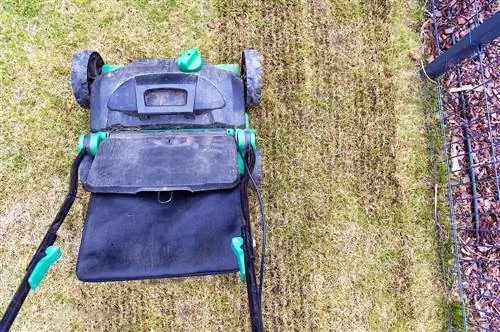
A scarifier can be used to loosen up clay soil under the lawn
Compacted clay soil makes life difficult for the noble grasses in the lawn. The delicate roots can hardly penetrate a compact topsoil and drown in waterlogging after every downpour. So that you don't have to remove the lawn to improve the clay soil, rent or buy a manual or motorized lawn aerator (€118.00 on Amazon), also known as an aerator or aerator. How to proceed correctly step by step:
- Mowing, scarifying and sweeping the lawn
- Aerate the area with 200 holes per square meter
- sanding and watering aerated lawn
- Repeat the measure every year in March/April and September/October
The procedures mentioned are helpful if there is no drainage in clay soil. At least for a while you can use this method to drain waterlogged garden soil. Are you interested in consistent rainwater infiltration? Then the work and cost of a pipe system with an infiltration pit is worth it. You can read tips for uncomplicated DIY drainage in garden clay soil in the next section.
Creating drainage in garden clay soil - tips

Drainage in the garden makes sense if the soil is very solid clay
Lawn will not grow on clay soil if the rainwater remains standing. Annual scarifying and aerating only solves the problem temporarily. If flowers, perennials and vegetable plants are left with wet feet after every heavy downpour, depressed growth and bad harvests are inevitable. Affected gardeners get to the root of the problem with permanently improved rainwater infiltration. The following tips outline a simple way to make clay soil with waterlogging more permeable using drainage:
Preparatory work
Measure the route of the pipe system for the drainage to the infiltration system precisely. You then create a detailed sketch plan so that you can precisely determine the material requirements. Make a note of slotted drainage pipes covered with coconut fiber on your shopping list. The special drainage pipes lead into a collecting pipe that allows the water to flow into a seepage trough. You will also need sand, gravel, grit, seepage fleece, wooden slats as formwork, spade, shovel, ideally a mini excavator or strong helpers for the strenuous excavation work.
Laying drainage pipes and collecting pipes
Slight gradients of 2 to 3 percent are crucial for how drainage works in garden clay soil. Regular checks with a spirit level guarantee compliance with this important premise when excavating the clay soil and then filling the pipe channels. The following guidelines are relevant to ensure that rainwater infiltration in the garden becomes a successful project:
- Dig channels for the drainage pipes (15-30 cm under lawn/turf, 80-150 cm under vegetable patch and orchard)
- Insert wooden boards into the pits as formwork
- Line pipe channels with seepage fleece
- Put a layer of sand to protect the fleece and the gravel pack above it
- Laying drainage pipes and collecting pipes
It is important to note that there is a sufficient distance between the drainage pipes and the basement of your home so that you do not have to struggle with wet basement walls. It must be ensured that rainwater from the drainage pipe does not enter the house's drainage shaft and flow into the sewer. Under these circumstances, trouble with the authorities is inevitable and wastewater fees skyrocket.
Seepage trough
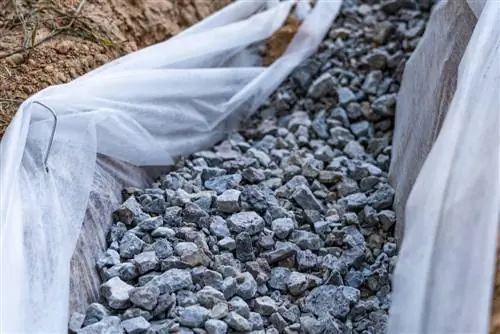
A seepage trough is the simpler variant of drainage
A seepage trough solves two problems in one operation. If the size of the garden area allows it, the hollow acts as a collecting basin for the collecting pipe of the drainage pipes and, as a natural wet biotope, fits harmoniously into the creative garden design. The following overview summarizes important key points:
- Dig a seepage trough below the collecting pipe of the drainage pipes
- ideally dig at the site down to a permeable layer of soil (no gravel pack or filter fleece necessary)
- Alternatively, line dense clay soil as a base with fleece and fill with sand and gravel
In contrast to the drainage shaft on the house, simple drainage in the garden clay soil does not require a building permit. This requirement applies as long as the construction is limited to optimizing natural rainwater infiltration into the lawn or garden soil. Any additional measures for draining clay soil are subject to legal regulations, such as the Water Resources Act or the building regulations. In many municipalities it is also forbidden to drain rainwater into the public sewer system using garden drainage. Please contact the responsible authority if your plans go beyond the simple drainage variant explained here.
Tip
The visible part of a garden drainage system is the seepage trough as a wet biotope. The pipes resting in the ground were quickly forgotten. Take photos of the route of the pipe system and keep the photos together with the sketch plan so that there are no unpleasant surprises later when doing soil work in the bed.
Ideal plants for clay soil - premium selection
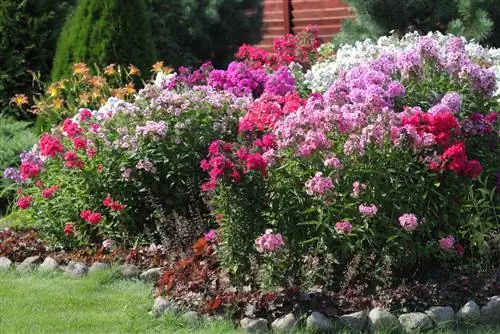
The phlox grows well on clay soil
Which plants actually like clay soil? Which trees grow on clay soil? To save you a long headache, we have put together the following table. These plants prefer to extend their roots in nutritious, heavy clay soil:
| Perennials/Vegetables/Herbs | botanical name | Shrubs/Groundcover | botanical name | Trees/fruit trees | botanical name |
|---|---|---|---|---|---|
| Aster, rough-leaf aster | Aster novae angliae | Roses | Pink | Amber tree | Liquidambar styraciflua |
| Flameflower | Phlox paniculata | hydrangeas | Hydrangea | Trumpet tree | Catalpa bignonioides |
| Sun Bride | Helenium | Blackcurrants | Ribes nigrum | Sequoia tree | Metasequoia glyptostroboides |
| Bergenie | Bergenia | White Willow | Salix alba | Mountain Maple | Acer pseudoplatanus |
| Magnificent Piers | Astilbe | White Dogwood | Cornus alba | Spruce | Picea |
| Peony | Paeonia officinalis | Purple Willow | Salix purpurea | Cedar | Cedrus |
| Tomatoes | Solanum lycopersicum | Shadow Green | Pachysandra terminalis | Apple tree | Malus domestica |
| Potatoes | Solanum tuberosum | Cotoneaster | Cotoneaster procumbens | Plum tree | Prunus domestica |
| Onions | Allium cepa | Buttonbush | Cephalanthus occidentalis | Cornelian cherry | Cornus mas |
| Carrots, carrots | Daucus carota subsp. sativus | Red Winterberry | Ilex verticillata | Quince | Cydonia |
| All kinds of cabbage | Brassica | hornbeam | Carpinus betulus | Blackthorn (large shrub) | Prunus spinosa |
| Chives | Allium schoenoprasum | Clematis | Clematis | Black elderberry (large shrub) | Sambucus nigra |
| Peppermint | Mentha piperita | Yew | Taxus baccata | ||
| Thyme | Thymus vulgaris | Tree of Life | Thuja |
The best lawn seeds for clay soil should primarily consist of deep-rooted grasses, such as grass panicle (Pos supina). When selecting the type of lawn, a distinction must also be made between whether it is located in the sun or in the shade. A look at the back of the packaging provides more information.
Excursus
Buy clay soil
Building on clay soil leaves behind a massively compacted topsoil. Instead of dedicating yourself to extensive soil improvement and drainage measures, you can remove the dense, waterlogged soil layer and buy fresh, top-quality clay soil. Sources for purchasing the best clay soil include local building material suppliers, container services and composting sites. Seasonally, civil engineering companies and horticultural companies have high-quality clay soil on offer as top soil at low prices.
Dispose of clay soil correctly
If you no longer have any use for clay soil after removal, you have various options. This is how you dispose of clay soil in an exemplary manner:
- Sift clay soil, transport it with a trailer and hand it over to the horticultural company or the municipality free of charge
- Rent a truck and driver, shovel clay soil onto the loading area and have it driven away
- publish sifted clay soil (without building rubble) in the soil exchange for self-collectors
- Order disposal to a specialist container company
It is important to note that despite all the complaints about removed clay soil, it is still a living natural asset that must not be carelessly destroyed.
Frequently asked questions
How to prepare clay soil for lawn?
Lawn grasses want their substrate to have a loose, permeable consistency. So that compacted, waterlogged clay soil enjoys the goodwill of the noble grasses, create a coarse subgrade and a fine subgrade in two steps. In the first phase, you dig up the clay soil, removing roots, weeds and stones. Then work in lawn sand at 4 kg/m² and let the rough subsoil rest for two weeks. For the fine subgrade, rake, weed and rake the improved clay soil until a fine, crumbly consistency is created.
Which sand is best for improving clay soil?
Fine-grained quartz sand is a good choice for allowing rainwater to seep away more quickly in dense clay soil. However, the first choice is associated with comparatively high costs with an average price starting at 0.24 euros/kg. Soil improvement is cheaper with fine-grained, washed building sand, which costs 0.12 euros/kg.
In our garden, sandy clay soil allows rainwater to seep away far too quickly. What to do?
Mature compost and bark humus improve the water storage capacity in sandy loam soil. The higher the sand content, the more organic soil additives you should incorporate. Green manure every spring is beneficial for soil quality. Plants such as lupins, bee friend, marigolds or red clover enrich sandy loam soil with green and root matter so that soil water does not seep away as quickly.
Tip
If clay soil had a say in the garden, lava granules would be at the top of the wish list for soil improvement. Cooled lava with a grain size of 4-16 mm or 16-32 mm effectively prevents unfavorable compaction and the resulting waterlogging. Because lava granules do not rot, clayey garden soil benefits from reliable rainwater infiltration for many years.

